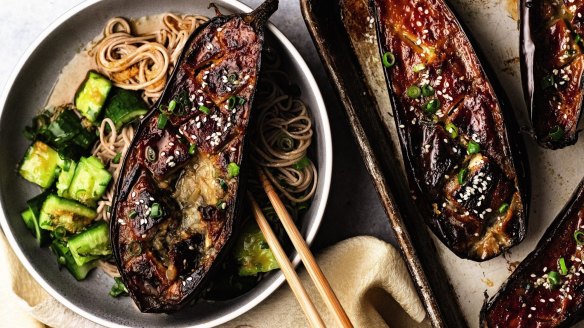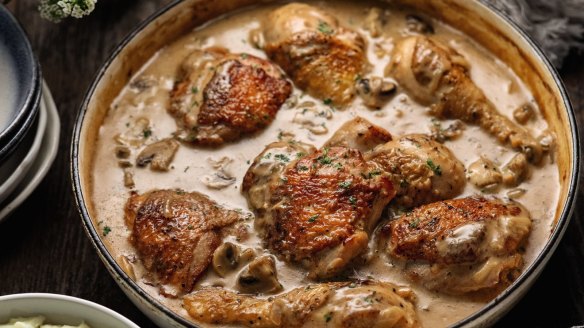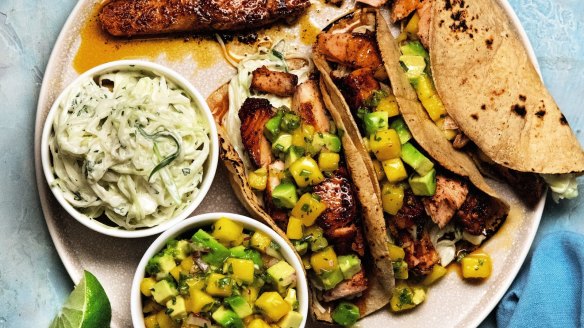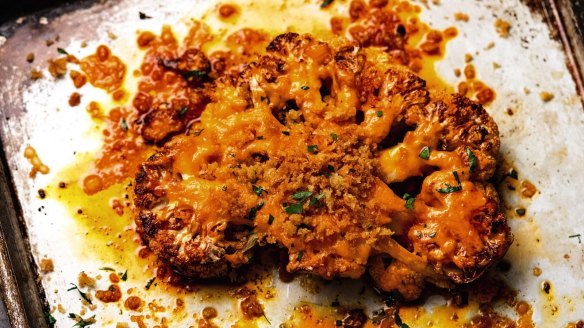Four easy dinner ideas from Nagi Maehashi's new RecipeTin Eats cookbook

What to cook for dinner? That's the perennial problem facing every home cook, and Nagi Maehashi of RecipeTin Eats sets out to solve it with her debut cookbook, Dinner.
From 10-minute weeknight winners to special occasion feasts, the collection includes more than 150 of Maehashi's best recipes, all with her signature simplicity, no-fail technique and big, bold flavours.

Here are four to try at home.
Miso-glazed eggplant
There's a good reason miso is a staple of Japanese food. It's packed with umami (read: savoury flavour!), which means it's a brilliant shortcut to add a ton of taste with very few other ingredients. Here, I'm using miso to slather on eggplant before baking. It sets into a beautiful golden glaze, which fills the slits that open up as the eggplant cooks. As for eating it? Smoosh it all up so the sweet glaze mixes with the creamy flesh. Eat with chopsticks, to be vaguely authentic, but there's no shame in using a spoon!
INGREDIENTS
Miso glaze
- 3 tbsp (45g) red miso (see note 1)
- 1½ tbsp mirin
- 2 tsp cooking sake
- 1½ tsp white sugar
Eggplant
- 2 x 400g eggplants (about 22cm long)
- 2 tbsp canola oil
- canola oil spray (optional)
To serve
- sesame seeds
- finely sliced spring onion
- chopped coriander leaves (optional)
METHOD
- Preheat the oven to 180C fan-forced (200C conventional).
- Miso glaze: Mix the ingredients in a bowl until smooth. Prepare eggplant: Cut the eggplants in half lengthways and place them flesh-side up. Using a small knife, cut 2.5cm diamonds into the flesh, almost through to the skin. Don't cut through the skin (though if you do a bit, it's OK!)
- Roast: Place the eggplant on a baking tray, then brush the surface with oil. Roast for 30 minutes. Remove from the oven and brush with two-thirds of the miso glaze. Bake for a further 15 minutes, then brush with the remaining miso glaze. Bake for a further 10-15 minutes or until the eggplant is soft all the way through (cook time will depend on the eggplant size; use a butter knife to check if it's soft).
- Caramelise: Flick the oven grill on high with the shelf 25cm from the heat source. Spray the surface of the eggplant with canola oil, if you want better caramelisation! Grill for 3-6 minutes, or until the surface is caramelised. Don't walk away – it can burn easily!
- Serve: Transfer to serving plates, sprinkle with sesame seeds and sliced green onion and serve straight away. Ideal served over soba noodles and chunks of smashed cucumber drizzled with a dressing and a sprinkle of chopped coriander.
Serves 4
NOTES
1. This recipe will work with most types of miso, including dashi miso or shiro miso. But do not use saikyo miso or sweet miso (too sweet).
2. Asian/Japanese eggplants (the thinner, smaller ones) can also be used. Do not score, and reduce baking time to around 30 minutes in total, brushing with glaze and finishing under the grill as per the recipe.
Leftovers Fridge 2 days, though best served fresh as cooked eggplant does get a bit saggy and soft!

Chicken fricassee
If I could bottle the sauce in this country-style French stew, I would.This is a dish taught to me by the super-talented chef Jean-Baptiste Alexandre. He was born, raised and trained in France, and now resides right here in my hometown of Sydney. So it goes without saying this recipe is par excellence! Creamy, silky and rich with the flavours of chicken, herbs and wine, you'll be mopping your plate clean with bread. While this is terrific made with store-bought stock, if you can manage homemade, I highly recommend it as it will catapult this dish into wow territory!
INGREDIENTS
- 4 x 250g skin-on, bone-in chicken thighs (see note 1)
- 4 x 150g chicken drumsticks (see note 1)
- 1 tsp cooking salt
- ½ tsp black pepper
- 60g unsalted butter
Creamy mushroom sauce
- 300g small-ish white button mushrooms, halved
- 2 brown onions, halved, then sliced 6mm thick
- 1 fresh bay leaf (or 1 dried bay leaf)
- 3 thyme sprigs (or ½ tsp dried thyme)
- 2 garlic cloves, finely minced
- 3 tbsp (30g) plain flour
- ½ cup (125ml) chardonnay wine (see note 2)
- 3 cups (750ml) low-salt chicken stock
- ¼ tsp cooking salt
- ¼ tsp black pepper
- ⅔ cup (170ml) thickened cream
- 2 tbsp roughly chopped parsley (optional)
METHOD
- Brown chicken: Pat the chicken dry with paper towels and sprinkle all over with salt and pepper. Melt the butter over medium-high heat in a very large, deep frying pan (see note 3) with a lid. Add the chicken thighs, skin-side down, and cook for 4-5 minutes until the skin is golden brown. Turn and cook the other side for 1 minute. Transfer to a plate. Add the drumsticks to the pan and brown them as best you can. I do 3 sides, about 2 minutes each. Transfer from the frying pan to the plate with the thighs.
- Creamy mushroom sauce: Add the mushrooms, onion, bay leaf and thyme to the pan. Cook for 5 minutes until the mushrooms are lightly golden. Add the garlic and stir for 30 seconds. Add the flour and cook for 1 minute. Add the wine, chicken stock, salt and pepper and stir, scraping the base of the pot to dissolve the brown residue stuck to the pan (the "fond") into the sauce.
- Simmer covered: Return the chicken, skin-side up, to the pan with the sauce. Once the sauce comes to a simmer, adjust the heat so it's bubbling gently (not rapidly) but constantly. This is medium-low on my stove. Cover with a lid and simmer for 10 minutes.
- Simmer uncovered: Remove the lid and let the fricassee simmer for a further 20 minutes. The chicken will be cooked when the meat's internal temperature is 75C or slightly higher.
- Finish sauce: Transfer the chicken to a plate, leaving the sauce in the pan. Add the cream to the sauce and stir. Once the sauce comes back up to a simmer, taste it and add more salt if desired.
- Serve: Return the chicken to the sauce, then remove the pan from the stove. Sprinkle with parsley (if using) and serve! Traditionally, fricassee is served over creamy mashed potato or white rice. It's also ideal with short pasta like penne, ziti or macaroni. For a side dish, steamed vegetables, or leafy greens drizzled with French dressing would be a lovely accompaniment.
Serves 4
NOTES
1. The chicken needs to be skin-on, bone-in thigh and leg pieces so they don't overcook and dry out. If you are dead set on making this with boneless breast, brown it as per the recipe, then simmer the sauce with the lid off for 15 minutes (to reduce), then add the breast and simmer with the lid on for 6 minutes or until the internal temperature reaches 67C. For boneless thigh, do the same except the internal temperature should be 72C.
2. Any dry white wine will work here, though chardonnay is my preference because it adds good flavour. For a non-alcoholic substitute, replace with more chicken stock.
3. A large pot also works. The shallow casserole pot I use is 29cm wide and 6cm deep (3.4 litres). No lid? Just use foil.
Leftovers Fridge 4 days, freezer 3 months.

Chipotle salmon tacos
No, this isn't authentic but everything in these salmon tacos just works so well that it still rates as one of the best tacos I've invented in recent years! The salmon marinade is a little bit spicy, a little bit smoky and so good with the oily salmon. Having both lime slaw and mango avocado salsa for the toppings requires a bit of added effort, but the refreshing effect they bring is unbeatable. I promise they're worth the work! However if you're pressed for time, suggestions for simpler alternatives are in the notes.
INGREDIENTS
- 600g skinless salmon fillets, cut lengthways into 1.5 cm thick slices (see note 1)
- 1 tbsp extra-virgin olive oil
Chipotle marinade
- ½ tsp each paprika, ground coriander and onion powder
- 1 tsp ground cumin
- 1½ tsp chipotle powder
- 1½ tsp cooking salt
- 1 tbsp lime juice
- 1 tbsp extra-virgin olive oil
To serve
- 12 x 15cm small tortillas, warmed
- 1 quantity taco slaw (see recipe)
- 1 quantity mango avocado salsa (see recipe)
- 3 limes, cut into wedges
METHOD
- Marinate salmon: Mix the chipotle marinade ingredients in a press-seal bag (see note 2). Add the salmon, seal the bag and massage to coat the salmon in the marinade. Leave on the counter for 20 minutes (see note 3).
- Cook salmon: Heat the oil in a large non-stick frying pan over medium-high heat. Cook the salmon for 1 minute on each side, then transfer to a plate.
- Rest the salmon for 3 minutes, then roughly break into chunks (or leave whole for DIY option).
- Serve: Stuff the warmed tortillas with the taco slaw and top with salmon chunks. Spoon over some mango avocado salsa (see note 4), add a squeeze of lime juice and enjoy!
Serves 4 (makes 12 tacos)
NOTES
1. The idea here is to cut thinner strips of salmon to increase the surface-area-to-flesh ratio for extra flavour and speedy marinating. No need to get too hung up about perfect slices – it gets flaked anyway! If you can only get skin-on salmon, it's not a big deal – just flake the salmon flesh off the skin once cooked.
2. The used press-seal bag can be washed in warm soapy water for reuse. Otherwise use a bowl, but increase the marinade by 50 per cent.
3. Only marinate up to 2 hours at most. Don't marinate overnight as the fish is too delicate and may become overly soft.
4. For a faster option, skip the slaw and mango salsa. Instead, use finely sliced iceberg lettuce, avocado, sliced tomato, finely chopped red onion, coriander leaves, a dollop of sour cream and squeeze of lime juice. YUM.
Leftovers Fridge 3 days (cooked salmon). Not suitable for freezing.
Mango avocado salsa
This fresh and summery salsa is so juicy you won't need a separate sauce with your tacos.
INGREDIENTS
- 1½ cups (255g) cubed mango (1cm pieces)
- 1½ cups (225g) cubed avocado (1cm pieces)
- 1⁄4 cup (30g) finely chopped red onion
- 3 tbsp finely chopped coriander leaves
- 1½ tbsp deseeded and finely minced jalapeño (adjust to taste)
- 3 tbsp (45ml) lime juice
- 1½ tbsp extra-virgin olive oil
- 1⁄2 tsp cooking salt*
METHOD
- Place everything in a bowl and toss. Serve immediately.
Makes 3 cups, enough for 12 tacos
Leftovers Best made fresh. To prepare ahead, don't add the lime, oil and salt until just before serving.
Taco slaw
This slaw goes with everything. It's great stuffed into burritos and tacos, but a heap on a plate also makes a great side salad to cut through rich, spicy meats. Six cups of shredded cabbage sounds like a lot for 12 tacos, but it collapses to almost half the volume once it wilts.
INGREDIENTS
- 6 tightly packed cups (540g) finely shredded green cabbage
- 1 cup (55g) finely sliced spring onion (sliced diagonally)
- ½ cup (24g) finely chopped coriander leaves
Dressing
- 1⁄2 tsp finely minced garlic
- 1⁄2 cup (100g) sour cream (or use yoghurt)
- 2 tbsp mayonnaise (or 4 tsp olive oil)
- 2 tsp lime zest (see note 1)
- 4 tsp lime juice (see note 1)
- 1⁄2 tsp cooking salt
METHOD
- Mix the dressing ingredients in a large bowl. Add the cabbage and toss to coat. Set aside for 20 minutes until the cabbage wilts. Nobody wants spiky bits of cabbage in their tacos!
- Add the spring onion and coriander and toss well again. Ready for use!
Makes 5½ cups, enough for 12 tacos
NOTE
1. No limes? Use lemon instead, but skip the zest. Otherwise, apple cider vinegar makes a good substitute.
Leftovers Fridge 3 days. Toss before use.
Warming tortillas
Warming tortillas makes them pliable as well as bringing out the flavour. The same methods can be used for both flour and corn tortillas. My default method is the oven, for convenience, because you can heat a lot of tortillas in one go. My ideal method is toasting the tortillas over an open flame. Charred bits = extra flavour!
What you need
- Oven: Separate the tortillas (sometimes they are stuck together), then stack (up to eight tortillas) and wrap with foil. Make more foil packets as needed, for more tortillas. Place in a preheated 200C (180C fan-forced) oven for 15 minutes. Keep the tortillas warm in the foil packets until serving.
- Naked flame: Place the tortilla directly onto the flame of a gas stove on medium heat. Leave for 15-20 seconds until you get some charred spots, but before it goes crispy. Flip with tongs and repeat on the other side. I will typically have multiple burners going at the same time!
- Stove: Heat a non-stick frying pan over medium-high heat. Place the tortilla in the pan (no oil) and leave for 20 seconds. Flip and heat the other side for 25 seconds or until you get a few little brown pots, but don't let it go crispy or it will break when folded/rolled. Remove and repeat. Speed things up: get a few pans going at the same time.
- Microwave: Separate the tortillas, then stack six to eight on a paper towel-lined plate and cover with another paper towel. Microwave on high for 40 seconds. Method not recommended for tacos as they get a bit too steamy and soft.
METHOD
- Remove tortillas from packet: Separate one by one, because sometimes they are stuck together, then proceed with one of the methods.
- Keeping tortillas warm: Stack warmed tortillas in a clean tea towel and keep wrapped so they stay warm. If warming ahead of time, they can be kept wrapped in foil in a 50C oven (conventional and fan-forced).
NOTES
1. Most flour tortillas are pliable enough straight out of the packet, so I only warm them up for tacos because they taste better.
2. Corn tortillas are much more brittle than flour tortillas. They MUST be warmed thoroughly to make them soft and pliable before use or they will break!
3. Once corn tortillas become even a bit stale, they are much more prone to breaking. Resuscitate them by dunking briefly in water, then reheat using the stove or naked flame method. Or spritz lightly with water and reheat using the oven method.

Simple, very tasty cauliflower cheese steaks
Also known as "An Easy Way to Make Cauliflower Irresistible".
Here's a cauliflower steak recipe that won't have you running for the hills. Not when there's cheese, garlic, spices and a crunchy parmesan crumb involved! It's as good as simple meatless mains get. I like to use red Leicester cheese for the eye-catching orange shade it gives the cauliflower. But you can use your favourite melting cheese or whatever you have on hand.
INGREDIENTS
- 1 large head of cauliflower, cut into 2 x 2.25cm thick steaks (see note 1)
- 4 tsp extra-virgin olive oil
- ¾ cup (75g) shredded red Leicester cheese (see note 2)
- ½ tsp finely chopped parsley
Seasoning
- ½ tsp smoked paprika
- ½ tsp garlic powder
- ¼ tsp ground coriander
- ¼ tsp cooking salt
- ⅛ tsp black pepper
Parmesan crumb
- 1 tightly packed tbsp (7g) finely grated parmesan
- 2 tbsp panko breadcrumbs (see note 3)
- ⅛ tsp cooking salt
- 1 tbsp extra-virgin olive oil
- 2 tsp finely chopped flat-leaf parsley
METHOD
- Preheat the oven to 220C fan-forced (240C conventional). Line a baking tray with baking paper.
- Season cauliflower: Combine the seasoning ingredients in a bowl. Place the cauliflower steaks on the prepared tray, then drizzle one side of each steak with 1 teaspoon of oil. Sprinkle evenly with half the seasoning (use your fingers). Turn the cauliflower and repeat.
- Roast: Put the tray in the oven and roast the cauliflower for 15 minutes. Flip, then roast for a further 10 minutes. Remove from the oven – the cauliflower should be just about cooked.
- Turn the oven down to 180C fan-forced (200C conventional). Cover with the red Leicester cheese, then bake for a further 5 minutes until the cheese is melted.
- Parmesan crumb: While the cauliflower is roasting, mix the parmesan, breadcrumbs and salt in a bowl. Heat the oil in a small non-stick frying pan over medium heat. Add the breadcrumb mixture and stir for 1 minute until just golden (the parmesan will clump, that's normal!). Transfer to a bowl, then let it cool. Crumble with your fingers, then stir in the parsley.
- Serve: Transfer the cauliflower to serving plates. Sprinkle with the parmesan crumb and parsley (if using). Enjoy with a side of leafy greens or a garden salad.
Serves 2
NOTES
1. To cut the cauliflower steaks, remove the outer leaves and trim the excess stalk off the cauliflower. Cut right down through the middle, then cut a 2.25-2.5cm thick slice from one half, keeping the core intact (the base keeps the steak together). Repeat with the other half so you have two steaks. (The recipe video is helpful here!) Reserve the leftover cauliflower for another purpose.
2. Red Leicester cheese has that beautiful orange colour you see in the photo. But it can be substituted with your favourite melting cheese, such as cheddar, tasty cheese, colby or gruyere. If you use mozzarella, mix through 2 tablespoons of grated parmesan for flavour. For this recipe, store-bought pre-grated parmesan can be used (the sandy type, not the shredded type).
3. Ordinary breadcrumbs also work well. The crumb clumps even more so you get crunchy balls!
Leftovers Fridge 3 days, though best made fresh as cauliflower goes a bit soggy. Not suitable for freezing.
This is an edited extract from RecipeTin Eats: Dinner by Nagi Maehashi, published by Macmillan Australia, RRP $44.99, photography by Nagi Maehashi. Buy now